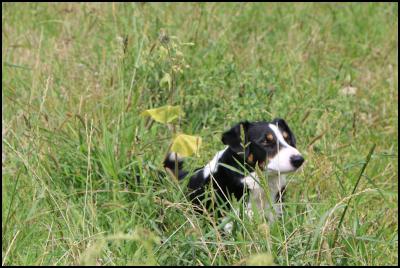Detecting those doggone weeds
7 March 2017
Detecting those doggone weeds

It’s definitely
low-tech but Rusty the dog’s nose for trouble is proving a
potentially valuable tool in Waikato’s hunt for the
dreaded invasive weed velvetleaf.
Rusty, a seven year old border collie specifically trained to detect velvetleaf, flew up from Invercargill last week with his handler John Taylor. He worked with Waikato Regional Council’s biosecurity team on a range of properties to help sniff out the pesky plants which have gained a potentially dangerous foothold in the region.
One of the council’s pest plant biosecurity officers Richard Gribble says Waikato landowners have been great at keeping an eye out for velvetleaf and at taking eradication measures when they find the pest plant on their properties.
“But the weed can be very hard to spot, especially on large fields with crops like maize and fodder beet, so in those cases we need some special tracker skills like Rusty’s.”
Mr Gribble says it’s the first time such a sniffer dog has been used in the region for this purpose so last week’s work was a chance to test out how effective this detection method can be here.
“Rusty showed some real skill and we believe he may be our secret weapon in future to find velvetleaf plants in areas where it’s usually hard to spot, a bit like a needle in a hay stack.
“Over the course of a week, he’s been able to find almost 100 plants and we estimate that without his help, we would have found roughly 30 per cent of those plants.”
Richard says the council will now assess how Rusty can be used again in future.
John Taylor says Rusty had quickly picked up velvetleaf training down south. “He pretty much got it after a day, and after three weeks of intensive training he became very good at detecting velvetleaf.
“Rusty’s at his best in relatively cool conditions, so the warm weather up here has been a bit of challenge, as well as being in a new environment with new smells.
“All things considered, I think he’s adapted really well and has been showing promise over the last couple of days.”
Meanwhile, Richard recommends that fields with tall crops, like maize, can best be checked for velvetleaf in November or December when the plant hasn’t yet reached the height of the fence line.
Grazing paddocks are best checked in the warmer summer months, which provide an ideal temperature for the seeds to germinate. “During February and March, we really see a surge in little velvetleaf seedlings popping up, and it’s best to eradicate them before the seed can spread further.”
The regional council has been supporting farmers since 2011 to find and eradicate velvetleaf in the region. Velvetleaf is considered one of the world’s worst cropping weeds and reduced yields, combined with the cost of control, could mean a significant loss of income if not controlled.
Velvetleaf has been confirmed on 34 properties and pest plant officers are now working with the landowners to develop biosecurity management plans for their properties. In addition pest plant officers have begun inspecting about 70 properties found to be at risk of being infested with velvetleaf in April last year.
ends


 Gordon Campbell: On bird flu, AUKUS entry fees and Cindy Lee
Gordon Campbell: On bird flu, AUKUS entry fees and Cindy Lee Labour Party: Penny Drops – But What About Seymour And Peters?
Labour Party: Penny Drops – But What About Seymour And Peters? Government: PM Announces Changes To Portfolios
Government: PM Announces Changes To Portfolios Family First: Just 1 In 6 Oppose ‘Three Strikes’ - Poll
Family First: Just 1 In 6 Oppose ‘Three Strikes’ - Poll Labour Party: Budget Blunder Shows Nicola Willis Could Cut Recovery Funding
Labour Party: Budget Blunder Shows Nicola Willis Could Cut Recovery Funding  Government: Urgent Changes To System Through First RMA Amendment Bill
Government: Urgent Changes To System Through First RMA Amendment Bill Peace Movement Aotearoa: Global Military Spending Increase Threatens Humanity And The Planet
Peace Movement Aotearoa: Global Military Spending Increase Threatens Humanity And The Planet


